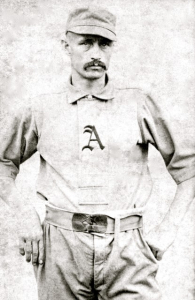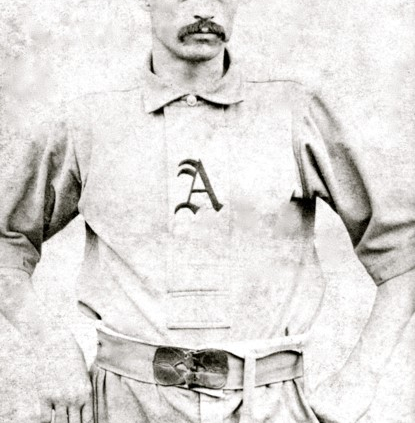May 1, 1883: Philadelphia Athletics shut out Alleghenys on Opening Day
 Many of the Athletics faithful in the crowd of over 10,000 who watched the final exhibition game of the spring between their American Association heroes and the new Philadelphia team in the National League must have left the Jefferson Street Grounds in Philadelphia not knowing quite what to make of their team’s prospects for the coming 1883 season.1 Clearly management had upgraded the roster, especially with the addition of first baseman Harry Stovey and pitcher Bobby Mathews. Indeed, so talented was the team’s lineup that Sporting Life anointed the Athletics as the “strongest [club] in the American Association.”2
Many of the Athletics faithful in the crowd of over 10,000 who watched the final exhibition game of the spring between their American Association heroes and the new Philadelphia team in the National League must have left the Jefferson Street Grounds in Philadelphia not knowing quite what to make of their team’s prospects for the coming 1883 season.1 Clearly management had upgraded the roster, especially with the addition of first baseman Harry Stovey and pitcher Bobby Mathews. Indeed, so talented was the team’s lineup that Sporting Life anointed the Athletics as the “strongest [club] in the American Association.”2
Yet this supposed juggernaut had lost three straight exhibition games to the upstart Quakers, of whom very little was expected in their first season in the National League, before rallying to take the final three contests.3 Perhaps even the Athletics themselves weren’t sure what to expect as they headed for the train station for the long ride to Pittsburgh for the 1883 season opener against the Alleghenys at Exposition Park.4
Since the Athletics spent the evening hours on the train, the players were not tempted to test management’s 11:30 P.M. curfew designed to curtail carousing. Even without such a restriction, however, the Philadelphia team was probably in better condition than the Alleghenys, who were “reputed to be the hardest drinking team of all-time.”5 Nor were the Pittsburgh club’s concerns limited to the condition of their players because there was so much water on the field from spring rains that the game was at risk. But Exposition Park had two fields and the upper one was sufficiently water-free to allow the game to be played. An estimated crowd of between 1,500 and 2,500, a fairly good crowd by Allegheny standards, turned out to watch the game played under mostly cloudy skies with temperatures in the low to mid-60s.6 Hung over or not, the Allegheny players had to face the Athletics’ new ace pitcher, 31-year-old veteran right-hander Bobby Mathews. Entering his 11th major-league season, Mathews was coming off a bounce-back season in 1882 with the Boston Red Stockings. Mathews went 19-15 with a 2.87 ERA as he overcame arm trouble that had plagued him for five seasons. Although he was only 5-feet-5 and 140 pounds, Mathews effectively changed pitches and speeds to confuse batters whose weaknesses he knew all too well.7 Mathews’ repertoire included a curveball and a spitball, both of which he used to hold the home team scoreless for the first four innings.8
The Athletics were equally stymied by southpaw Denny Driscoll of Pittsburgh. Driscoll, who had posted a 13-9 season with a league-leading 1.21 ERA in 1882, held the Athletics scoreless through four innings. Philadelphia’s fortunes changed for the better in the fifth, however, aided by some sloppy fielding by the home team. Fred Corey reached first base on a throwing error by third baseman Joe Battin and that miscue was followed by a wild pitch by Driscoll and a bad throw to second by Jackie Hayes, the Pittsburgh catcher. With the door to home plate thus set ajar, consecutive singles by Ed Rowen, Bob Blakiston, and Mathews himself sent three runs across the plate.9 The Athletics added another run in the eighth when Jack O’Brien doubled to drive in Mike Moynahan, who had singled.10 In fact, all, but one of Philadelphia’s runs were superfluous as Mathews shut out the Alleghenies on four hits. Hayes, Pittsburgh’s catcher, had two of those hits, including a double that made him the only Allegheny to reach second. (He advanced no farther.)11 Mathews did walk one opposing batter (he may have been helped by the fact that it took seven balls for a walk at this time in baseball history), but struck out seven while benefiting from one double play behind him.12 Mathews also collected two hits, as did Moynahan, O’Brien, and Blakiston. Stovey, who reportedly “could do everything on a ball field, and do it better than almost anyone else,” was held hitless, but on this day, at least, he wasn’t needed.13
Mathews received accolades from the Philadelphia Inquirer, which noted that the “Alleghenies could not understand Mathews’ manipulation of the sheep skin,”14 while the Times (of Philadelphia) called it a “walk-over” because Pittsburgh didn’t have “the ghost of a chance against Matthews’ pitching.”15 Apparently when the home team did have a baserunner, he ran the bases poorly, which both papers cited as an additional reason for Philadelphia’s victory, although they provided no details.
The shutout was the 15th of Mathews’ long career (he would have five more), but his Opening Day whitewash of the Alleghenys was the only one the Athletics recorded in 1883. Back home in Philadelphia, the result must have made those worried about the team’s prospects feel somewhat more confident, at least for one day. And those inclined to bet on their local heroes could take additional comfort from the Times’s conclusion that unless Pittsburgh improved, “Philadelphia people can bet on a certainty in the remaining games on their own club.”16 This proved to be sage advice as the Athletics dominated the Alleghenys and won 12 of the 14 games between the two teams.
Sources
In addition to the sources cited in the Notes, the author consulted Baseball-Reference.com and Retrosheet.org.
Notes
1 “The Athletics Third Victory,” Philadelphia Inquirer, May 1, 1883: 3.
2 “The Home Team: Sketch of the Men who Constitute the Local Teams,” Sporting Life, April 15, 1883: 2.
3 David Nemec, The Beer and Whiskey League: The Illustrated History of the American Association – Baseball’s Renegade League (Guilford, Connecticut: Lyons Press, 2004), 44-46.
4 Philadelphia Inquirer, May 1, 1883: 3.
5 Nemec, 48-49.
6 Philip J. Lowry, Green Cathedrals: The Ultimate Celebration of Major League and Negro League Ballparks (New York: Walker Publishing Company, 2006), 184; New York Clipper, May 12, 1883: 117; National Republican (Washington, DC), May 2, 1883: 1; Pittsburgh Post-Gazette, May 2, 1883: 4A.
7 John Shiffert, Baseball in Philadelphia: A History of the Early Game, 1831-1900 (Jefferson, North Carolina: McFarland & Co, 2006), 108; Brian McKenna, “Bobby Mathews,” SABR BioProject. sabr.org/bioproj/person/e7ad641f.
8 McKenna; Pittsburgh Daily Post, May 2, 1883: 4.
9 Pittsburgh Daily Post; New York Clipper.
10 New York Clipper.
11 Pittsburgh Post-Gazette, May 2, 1883: 2.
12 Cincinnati Enquirer, May 2, 1883: 2.
13 Shiffert, 107.
14 Philadelphia Inquirer, May 2, 1883: 8.
15 Times (Philadelphia), May 2, 1883: 1.
16 Times (Philadelphia).
Additional Stats
Philadelphia Athletics 4
Pittsburgh Alleghenys 0
Exposition Park
Pittsburgh, PA
Corrections? Additions?
If you can help us improve this game story, contact us.


